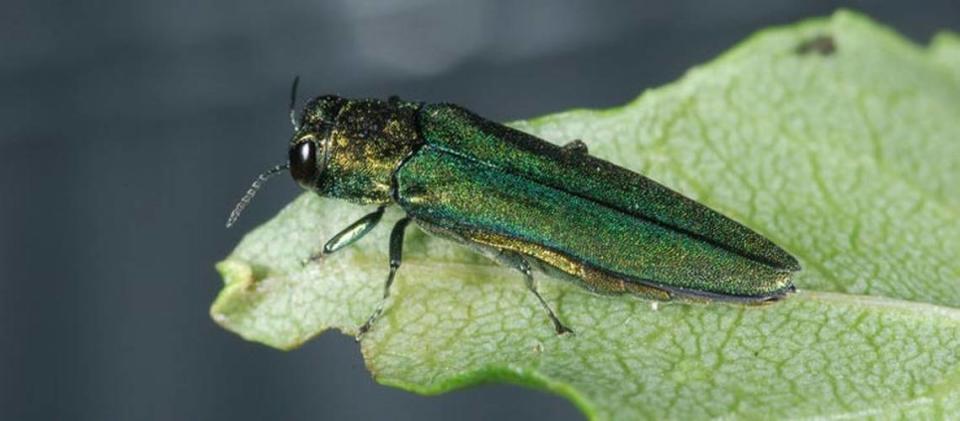These are Missouri’s most invasive animals. What should you do if you find one?
Missouri’s native ecosystems offer a breathtaking display of biodiversity — but some of the state’s natural habitats are under attack.
The damage caused by a handful of invasive species can be widespread and devastating, prompting conservation organizations to spend millions of dollars a year trying to either control or eradicate these animals.
Here are the invasive species recognized in Missouri:
Mammals: feral hogs
Aquatic animals: silver carp, invasive crayfish and zebra mussels
Birds: pigeons and European starlings
Insects: emerald ash borers
Some other species haven’t established breeding populations in the state quite yet, but officials are asking the public’s help spotting them in the wild. They include snakehead fish and spotted lanternflies.
Unlike in some states, there are no bounties on invasive species in Missouri that authorities actively encourage the public to help kill. However, there are still ways you can help stop their spread.
Can I shoot feral hogs in Missouri? How about other invasive species?
Feral hogs are the only invasive species in the state large enough to effectively shoot — but Missourians can only do so on their own private land.
“Feral hogs can be hunted on private lands but not on public lands in Missouri,” said Angela Sokolowski, the invasive species coordinator for the Missouri Department of Conservation.
That’s because game hunting for feral hogs on public land has been shown to maintain or increase the animals’ numbers rather than decreasing them. Shooting at a group of hogs may kill one or two, but the rest in their group — called a “sounder” — are likely to scatter, making them more difficult to capture.
While hunting these hogs used to be legal everywhere in Missouri, state conservation organizations are now taking a more targeted approach to trapping and killing large groups of these hogs at once.
If one is on your land, it’s OK to take a shot — but widespread hunting is no longer allowed.
How should the public handle invasive fish, insects and birds?
Silver carp are found in large rivers and tributaries across the state. If you catch one, don’t throw it back — these fish can be eaten or used as cut bait to catch other fish.
Silver carp can grow up to 3 feet in length, have toothless mouths with an underbite and have silver scales everywhere except their heads, which are scale-free.
Invasive crayfish are harder to control, as they’re nearly impossible to distinguish from native crayfish with the untrained eye. Crayfish that are native to one river in the state may be invasive to another if they’re improperly moved.
“We ask that folks don’t dump live bait back into any water source, because it’s possible that they’re dumping species that could become invasive and that aren’t found in that water body yet,” Sokolowski said.
The state also discourages residents from dumping water from household aquariums into waterways, as it can contain zebra mussel eggs. These tiny mussels reproduce rapidly and can clog drinking water intakes, boat hulls and engines and even power plants.

Emerald ash borers, a small green beetle decimating ash tree populations across the country, are so numerous in Missouri that killing the ones you see won’t make a difference in their numbers, Sokolowski said.
Instead, consider treating your ash trees with approved pesticides to protect them from these destructive bugs.
Other invasive species that the public can’t do much to remove are pigeons and starlings. These ubiquitous birds are already well-established in the state, and they can’t be hunted in most places for safety reasons and their large numbers.
Missouri’s most wanted: Report these invasive species immediately
There are two invasive species that haven’t established populations in the state yet — but officials are bracing for their imminent arrivals.
The northern snakehead is an invasive fish that officials advise the public to kill and report. Only a few sightings have been reported so far in the southwest “boot-heel” of the state, but Sokolowski warned that conservation groups expect the fish to spread.
This long, toothy, brown-mottled fish is usually found in slow water, but can survive on land for days at a time and can even “walk” on land using its bottom fins.
“Really the most important thing (the public) can do is report it to us,” she said. “Take pictures, share those pictures, or at least give us a report that (you) saw or captured one and give us a location so we can follow up on that.”
The other invasive pest her department is on the lookout for is the infamous spotted lanternfly, which feeds on more than 70 species of plants and can cause widespread damage to crops and native plants.
While no breeding populations have been confirmed yet in Missouri, Sokolowski asked the public to stay vigilant: If you see this distinctive insect, take a photo and report it to the Missouri Department of Conservation.
“If we do get those, we wouldn’t be opposed to people smashing it as has been the promoted thing to do in the eastern states where they’re so prevalent,” she said. “But it’s most important that we get a report and proof that we can double check on.”
Do you have more questions about environmental issues in Missouri or Kansas? Ask the Service Journalism team at kcq@kcstar.com.

